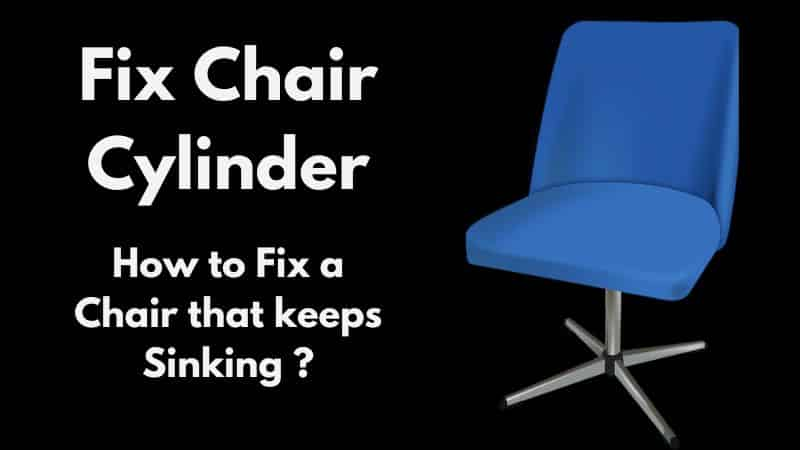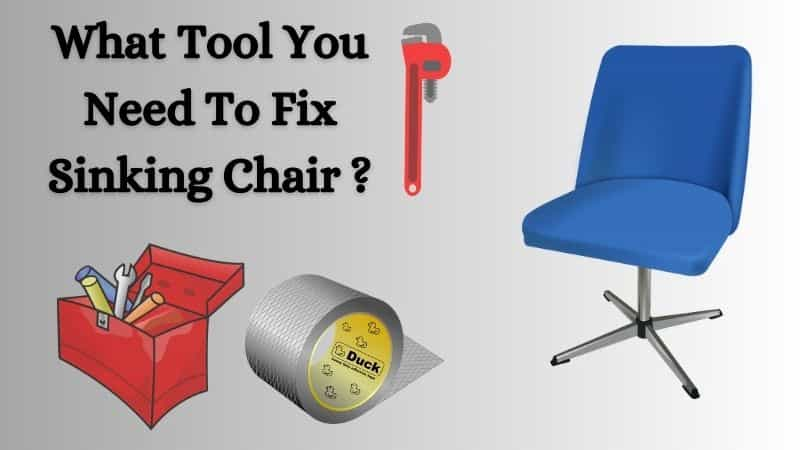Reviving Your Sinking Chair: An Essential Guide to Chair Repairs
Contents
- 1 How to Fix a Chair that Keeps Sinking
- 2 Deciphering the Mysteries of Your Sinking Chair
- 3 Safety Precautions: Preparing for a Safe Repair
- 4 Essential Tools for Resurrecting a Sinking Chair
- 5 DIY Symphony: How to Fix a Sinking Chair Using Simple Steps
- 6 Addressing Potential Challenges
- 7 Knowing When to Call a Professional
- 8 Recap and Maintenance: Ensuring a Comfortable Chair for the Long Haul
- 9 Frequently Asked Questions
How to Fix a Chair that Keeps Sinking
Chairs are more than simple pieces of furniture; they are integral to our comfort, our sense of style, and even our professional productivity. Whether we’re reclining in a comfortable chair on a sunny porch, seated at a stylish dining table, or settled into a sophisticated desk chair, we expect our chairs to provide reliable support. However, what happens when this central pillar of comfort and stability starts to fail us? If you’re one of the many who have found themselves dealing with the irritating issue of a sinking chair, rest assured, you’re not alone.
When your desk chair starts to sink, your productive day can quickly turn into a constant struggle of adjusting and readjusting. Suddenly, your favourite ergonomic chair becomes a source of constant frustration rather than comfort. However, understanding how to fix a chair that keeps sinking could be a game-changer, turning your discomfort back into a symbol of ease and stability.

Deciphering the Mysteries of Your Sinking Chair
Imagine this: You’re settled into your pneumatic chair, ready to tackle your tasks when, unexpectedly, you find yourself sitting lower than before. You adjust, but in no time, you’re sinking once again. This common issue arises due to the mechanics of office chairs.
Most desk chairs come with a pneumatic or extendable cylinder, also known as a hydraulic or gas cylinder, that is adjusted using a chair lever. This cylinder filled with compressed air or fluid acts as the chair’s “spring”, adjusting to your weight and maintaining your preferred seat height. However, over time, this piston mechanism might start to fail due to wear and tear, leading to the classic sinking chair syndrome.
Identifying a sinking chair is simple. If your chair gradually (or quickly) sinks without any instruction from you, or if it can no longer maintain the perfect height, you’re dealing with a sinking chair. The primary cause of this issue is the failure of the pneumatic cylinder due to regular wear and tear.
Tip: Some ergonomic chairs might come with a warranty that covers sinking issues. It’s worth checking this before diving into DIY repairs.
Although the temptation to replace your sinking chair with a new one might be strong, often the issue can be fixed, saving you the cost of a new chair. In the forthcoming sections, we’ll walk you through simple steps to remedy your sinking chair, much like our previous guide on how to silence a squeaky dining room chair. Let’s dive in!
Safety Precautions: Preparing for a Safe Repair
Though repairing a chair might not appear as dangerous as climbing a mountain, it still comes with its set of risks. Particularly, office chairs equipped with pneumatic systems contain mechanical components that can cause injury if mishandled.
Just as you would take precautions when fixing dining room chair legs, it’s essential to put safety first when tackling the issue of a sinking chair. Below are some safety measures to consider:
- Always disconnect any pneumatic systems before starting the repair.
- Maintain a clean and tidy workspace to prevent accidental slips or falls.
- Put on protective clothing, including gloves and safety glasses.
- Ensure your chair is stable before commencing your repair. Consider asking a friend for help or using a secondary object to prop the chair up.
Note: Safety precautions are crucial for a successful and safe repair job.
Essential Tools for Resurrecting a Sinking Chair
To fix your sinking chair, you’ll need a specific set of tools. The correct tools can transform an intimidating task into a smooth operation. Below is a list of necessary tools and their functions:

- Pipe Wrench or Pliers: To loosen or tighten parts of the chair.
- Screwdrivers: A set of differently sized screwdrivers will be useful for various screws on your chair.
- WD-40 or a similar lubricant: Useful for loosening stuck components.
- Hose Clamps or Jubilee Clips: These are essential in the hose clamp method of holding the extendable cylinder in place.
- Tape Measure: To determine the ideal height of your chair.
- Duct Tape: You’ll need this for one of our repair methods.
- Old Newspapers or Cloth: These will protect your workspace from oil stains or scratches.
In the upcoming section, we will walk you through two permanent solutions to fix your sinking chair: the hose clamp method and the pipe method.
DIY Symphony: How to Fix a Sinking Chair Using Simple Steps
Now that we’ve covered safety precautions and assembled our tools, it’s time to roll up our sleeves and dive into the repair process. We will present two distinct methods: the hose clamp method and the pipe method.
Method 1: The Hose Clamp Method
Step 1: Disconnect and Expose the Extendable Cylinder
Start by disconnecting the extendable cylinder from the chair’s wheelbase. Use your pipe wrench or pliers to unscrew the base if needed. Once removed, you’ll see the extendable cylinder — this is the primary source of your sinking chair woes.
Step 2: Clean the Extendable Cylinder
Using a cloth, clean the exposed cylinder to remove dust or grime. Apply a bit of WD-40 or a similar lubricant to facilitate the cleaning process.
Step 3: Apply the Hose Clamp or Jubilee Clip
Measure your preferred chair height and mark it on the cylinder. This mark is where you’ll apply your hose clamp or Jubilee Clip. Fit the clamp or clip around the cylinder and tighten it until it’s secure but not overly tight to prevent damage.
Step 4: Reassemble Your Chair
Reattach the wheelbase to the chair, making sure all screws are securely fastened. Test the chair by sitting on it. The hose clamp or Jubilee Clip should prevent the chair from sinking below your preferred height.
Method 2: The Pipe or PVC Pipe Method
This method is also referred to as the “chair saver kit.” It involves using a piece of pipe, preferably a PVC pipe, as a makeshift spacer to prevent your chair from sinking.
Step 1: Measure and Cut the PVC Pipe
Measure the height of the metal cylinder when it’s at the preferred height, then cut a piece of PVC pipe to that length. This pipe will act as a plastic spacer around your chair’s cylinder.
Step 2: Install the PVC Pipe
Disconnect the wheelbase from the extendable cylinder as described in Method 1. Slide the PVC pipe piece over the cylinder, then reassemble your chair.
Step 3: Test Your Chair
Once the chair is reassembled, sit on it to test if the sinking issue has been resolved. The PVC pipe should hold the chair at your desired height.
Keep in mind that while these steps form a basic guide, they can be tweaked according to the specific needs of your chair model for more guidance check out this video !!!
Addressing Potential Challenges
Like any DIY repair, you may encounter some challenges when fixing your sinking chair. Here are some common issues and their solutions:
Challenge: Hose Clamp or Jubilee Clip Slipping
Solution: If the hose clamp or clip slips down the cylinder when weight is applied, consider adding layers of duct tape for extra friction.
Challenge: Extendable Cylinder Won’t Disconnect
Solution: Apply a lubricant like WD-40 to loosen the connection and try again. If this doesn’t work, consider seeking professional help.
Challenge: Chair Sinks Even After Repair
Solution: If the chair still sinks after repair, the pneumatic system might be extensively damaged and may require replacement or a professional repair.
Knowing When to Call a Professional
While DIY repairs can fix many sinking chairs, some situations may warrant professional intervention. If your chair has extensive damage, if the pneumatic system is sealed, or if the chair continues to sink after the repair, consider consulting a professional. Attempting to repair a significantly damaged chair can lead to further issues, potentially compromising the chair’s functionality and safety.
Recap and Maintenance: Ensuring a Comfortable Chair for the Long Haul
Congratulations! You’ve journeyed through the process of diagnosing and repairing a sinking chair. From understanding why a chair sinks to learning about safety precautions, assembling necessary tools, and following a step-by-step guide to restoring your chair to its perfect height, you’ve covered a lot of ground.
The key takeaway from all of this is maintenance. Regularly checking your chairs for signs of wear and tear can prevent minor issues from escalating into larger problems. This proactive approach not only ensures your continued comfort but also prolongs the life of your chair. Remember, a comfortable chair contributes significantly to your productivity, whether it’s an ergonomic chair in your office or a simple desk chair at your dining table.
With patience, caution, and the right tools, you’re now empowered to tackle the common issue of sinking chairs. You’ve learned how to transform a troublesome sinking chair into a symbol of resilience and resourcefulness.
As we often say in the world of chairs, “A chair’s story is intertwined with your own. Make it a good one.”
Frequently Asked Questions
Q: Can all sinking chairs be fixed?
A: Many sinking chairs can be fixed using the methods outlined above. However, chairs with sealed or extensively damaged pneumatic systems may require professional help or replacement.
Q: Will these repair methods work for all types of chairs?
A: This guide primarily focuses on office chairs with pneumatic lift systems. The principles can, however, be applied to any chair with a similar mechanism. Always refer to your chair’s user manual or consult a professional if in doubt.
Q: How often should I check my chair for maintenance?
A: Regular maintenance checks can help detect minor issues before they turn into major problems. We recommend inspecting your chair every six months, but this frequency may vary depending on the chair’s usage and the environment in which it’s used.
Q: Can I use these methods to fix a sinking pneumatic chair?
A: Yes, both the hose clamp method and the pipe method can effectively fix a sinking pneumatic chair. Remember to always consider your chair’s specific design and consult the user manual or a professional if you’re unsure.

